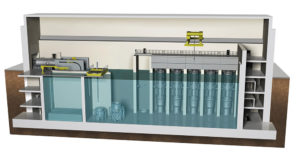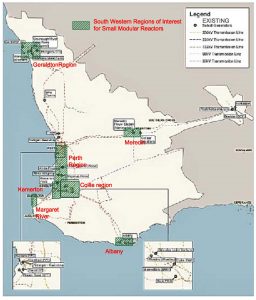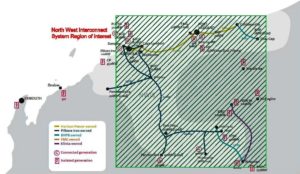
WA Regions of Interest
Edition 3, Revised 18/10/2016
Western Australian Electricity Existing and Projected
Western Australia is our largest state with a land area of 2,529,875 square kilometres. It has around 2.6 million people, or 11% of the national population. With its small isolated population and without any grid connection to the remainder of the nation it has unique challenges in establishing low carbon generation
There are two large electricity markets in Western Australia: the North West Interconnected System (NWIS) and the South West Interconnected System (SWIS). The two systems are not connected electronically. Additionally there is a significant resource sector generating capacity that is not interconnected.
Western Australian Generating Capacity
The approximate generating capacity in 2018[i] is listed in Table 1
| System | Reliable Capacity 2018 (MW) | Main fuel |
| North West Interconnected System (NWIS) | ||
| 725 | Gas | |
| South West Interconnected System (SWIS) | ||
| 3,093 | Gas and Diesel 3532MW installed | |
| 66 | Demand Management | |
| 139 | Renewables 642MW installed | |
| 1,561 | Coal | |
| Non-interconnected systems (Off grid) | ||
| 1005 | Gas and Diesel | |
| 49 | Hydro | |
| Total | 6,638 | |
Table 1 – Western Australian Generating Capacity – 2018
Ninety two percent of the population is concentrated in the south west corner where they receive power from the South West Integrated System (SWIS).
The state generated a total of 40.5 TWh[ii] of electricity in 2017. Approximately 18.7 TWh of electricity[iii] or about 59% of the state’s total was delivered in the SWIS. The total for the NWIS is taken as being 3.5TWh[iv]
The remaining 18.3TWh is assumed to be generated by off grid sources and industrial processes but is not properly accounted for at this stage.
Peak and Minimum demands are:
- SWIS, Peak is taken to be 3897MW[v] in summer.
Day min was 1600MW and now falling to 1200MW
Night Min is 1500MW
- NWIS, Assumed peak is 500MW
In the SWIS is about 91% of electricity is generated by fossil fuels with coal at about 50% and gas at 41% while in the NWIS the fossil fuel amount is closer to 99%.
Nuclear Energy in Western Australia
Large Reactor Option
The load on the SWIS is too low to support a traditional 1000MW large scale nuclear power plant.
Unplanned outages and refuelling would require uneconomic amounts of alternative generation.
Small Modular Reactor Option
Clearly a small self contained grid such as Western Australia’s is suited to smaller reactors in the sub 300MW class such as the proposed NuScale SMR’s. They would overcome the impacts of refuelling or reactor trips and would mean that the grid would require less extensive upgrades and energy storage can be avoided.
Currently one of the more advanced reactors being proposed and closer to licensing approval is the NuScale 360MW SMR which consist of 6 x 60 MW units. The 720MW version using 12 x 60MW units would also be an option. These plants would provide a very flexible energy generator that could also load follow.
Meeting 70% of the current annual demand would significantly stabilise prices and reduce emissions.
70% of the current annual output of 18.7 TWh gives 13.1 TWh.
This requires 5 NuScale type nuclear power plants providing 13.1 TWh at 87.5% capacity factor.
Regions of Interest for locating these plants in Western Australia
| Region of Interest | Location | Feature | Siting | Cooling | Comment |
| 1 | Geraldton Region | Coastal or Inland | Stable rock foundations | Once through sea water or hybrid air/water cooling | Grid upgrade required.
Assumes minimum plant size 1 x 360MW SMR’s |
| 2 | Perth Region | Coast and Inland
Replacing Kwinana, Cockburn and Pinjar Generators |
Stable rock or non rock foundations | Once through sea water or hybrid air/water cooling | Modest grid upgrade required. Assumes minimum plant size 2 x 360MW SMR’s = 720MW |
| 3 | Collie Region | Inland | Stable rock foundations | Hybrid wet/dry process. | Modest grid upgrade, close proximity to existing Collie region power stations. Assumes plant size 2 x 360MW SMR’s = 720MW |
| 4 | Kemerton | Replace Wagerup Gas Power station | Stable rock or non rock foundations | Hybrid wet/dry process. | Assumes minimum plant size 1 x 360MW SMR’s = 360 MW |
| 5 | Margaret River | Coastal Location, requires extensive grid upgrade | Stable rock foundations | Sea water cooling | Assumes minimum plant size 1 x 360MW SMR’s = 360 MW |
| 6 | Albany | Coastal Location, requires modest grid upgrade | Stable rock foundations | Sea water cooling | Assumes minimum plant size 1 x 360MW SMR |
| 7 | Carnarvon Basin/
Pilbarra |
Coastal Location, requires modest grid upgrade locally. | Stable rock foundations | Sea water cooling | Assumes minimum plant size 2 x 360MW SMR’s = 720 MW |
Regions of Interest for Small Modular Reactors in Western Australia
[i] https://en.wikipedia.org/wiki/List_of_power_stations_in_Western_Australia
[ii] Citation: Department of the Environment and Energy, Australian Energy Statistics, Table O, August 2018
[iii] Table 8 Sent Out Energy Forecasts, SWIS Electricity Demand Outlook, Independent Market Operator
[iv] ELECTRICITY SECTOR EMISSIONS MODELLING OF THE AUSTRALIAN GENERATION SECTOR, ACIL ALLEN April 2015
[v] PEAK DEMAND AND ENERGY FORECASTS FOR THE SOUTH WEST INTERCONNECTED SYSTEM- WESTERN AUSTRALIA ACIL ALLEN June 2019
Cooling WA Nuclear Plants
In Western Australia coal fired plants were constructed adjacent to available coal mines and other infrastructure.
New nuclear plants will where possible take advantage of the resource used for cooling at these plants.
In an effort to reduce the environmental impact upon inland water resources, modern nuclear power plants are being designed to use a hybrid system of air and water cooling. During periods of low water availability the degree of air cooling can be increased though at a modest reduction in power output.
At coastal plants such as those in the Geraldton, Perth, Pilbarra, Margaret River and Albany regions, sea water would be the sole form of cooling.
The tabulation shows the anticipated type of cooling at each plant
Western Australia’s long coastlines provide many options for locating nuclear power plants
While recirculating systems don’t add heat to the river or lake, they do consume water through evaporation. In Western Australia the availability of sizeable inland rivers are limited and so to overcome issues surrounding temperature rises in inland locations mechanically driven systems known as hybrid and recirculating systems can be used. These are now the only option used in the United States under their EPA guidelines.
An excellent and detailed outline of the cooling options is available at: Cooling Power Plants | Power Plant Water Use for Cooling – World Nuclear Association



